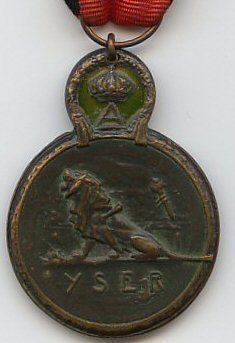Type Campaign medal Established 18 October 1918 | Status No longer awarded | |
 | ||
Awarded for Distinguished combat service along the Yser in 1914 | ||
The Yser Medal (French: Médaille de l'Yser, Dutch: Medaille van de IJzer) was a Belgian campaign medal of World War I, established on 18 October 1918 to denote distinguished service during the 1914 Battle of the Yser in which the Belgian Army stopped the German advance of the German invasion of Belgium.
Contents
Statute
The Yser Medal was awarded to the members of the Belgian Armed Forces who were part of the army fighting along the Yser river between 17 and 31 October 1914 that proved themselves worthy of the distinction. The medal could also be awarded to foreign nationals, members of allied military forces who took part in the Battle of the Yser. The medal could be awarded posthumously.
The Yser Medal was worn on the left side of the chest and when in the presence of other awards of Belgium, was placed directly after the Croix de Guerre (War Cross).
Medal description
The Yser medal was a 35 mm in diameter circular medal struck from bronze and surmounted by a smaller diameter green enamelled medallion. The obverse bore a naked helmeted man holding a lance (indicating the halting of the advance of the German forces), to his right, the relief inscription on three lines "17-31 OCT 1914". In the enamelled medallion, the relief inscription "YSER". The reverse bore the relief image of the left side of a roaring wounded lion lying on the bank of the Yser river, an arrow in his left shoulder, below the lion, the relief inscription "YSER", in the medallion, the Belgian royal crown over the relief letter "A", the monogram of King Albert.
The medal was suspended by a ring through the suspension loop to a red silk moiré ribbon with wide black edge stripes. The red denoting the spilled blood, the black denoting the mourning.
Notable recipients (partial list)
The individuals listed below were awarded the Yser medal:
Yser Cross
The Yser Medal was replaced by the Yser Cross (French: Croix de l'Yser, Dutch: Kruis van de IJzer) in 1934. The cross was of similar design to the medal displaying the same obverse and reverse except that it was in the form of a cross pattée. The Yser Cross was issued as a replacement to the earlier Yser Medal upon application and payment of a fee, consequently relatively few were issued as few veterans wanted to trade in their medal, and even fewer wanted to pay the fee. The Yser Medal and the Yser Cross could not be worn together, it was one or the other. Although issued with the same black and red ribbon as the Yser medal, many Flemish recipients opted for an unofficial black and yellow ribbon identifying them as Dutch speaking Belgians.
